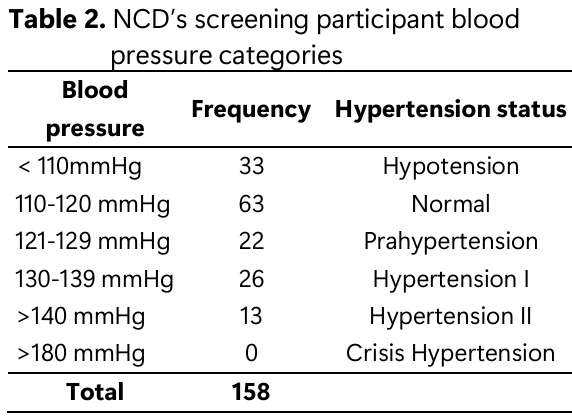Discriminant Analysis with the Approach of Direct Method and Stepwise Method to Analyze the Factors That Influence the Occurrence of Hypertension in the Sukamara Health Center Area
DOI:
https://doi.org/10.5281/zenodo.15307397Keywords:
Discriminant, Hypertension, SukamaraAbstract
Background: Discriminant analysis is one of the statistical techniques of multivariate analysis that can be used in analyzing dependency relationships, namely relationships between variables that can distinguish between response variables and explanatory variables or independent variables. There are several methods of approach taken so that the discriminant function is formed, including direct and gradual approach methods. This study is presented in a descriptive quantitative manner and the purpose of this study is to compare the factors that influence the occurrence of hypertension in the Sukamara Health Center area using direct and stepwise discriminant analysis. Methods: Data were collected using secondary data from the ASIK application in 2024 with 158 screening participants, with the response (dependent) variable being hypertension status and the explanatory (independent) variables being physical activity (X1), body mass index (X2), salt consumption (X3) and age (X4). Results: The results of the analysis showed that the salt consumption variable was the strongest discriminant variable because it was the variable with the largest coefficient with a canonical correlation value of (36.72% direct method, 36.12% stepwise method). This means that the salt consumption variable has the strongest separating power on the occurrence of hypertension in the Sukamara Health Center working area. Conclusions: In addition, based on the results of this study it is also known that the level of accuracy in predicting the incidence of hypertension, the direct approach method has a higher accuracy value (51.0%) compared to the stepwise approach method which only has an accuracy value of 48.4%, so it can be concluded that the direct approach method is the best research method in this study, and this method can also be used for research with other non-communicable disease data.
Downloads
References
Afifi, A. A. Dan V. Clark. 1996. “Computer Aided Multivariate Analysis.”
Ghozali, I. 2016. “Aplikasi Analisis Multivariete Dengan Program IBM SPSS 23.” Edisi 8.
J.F Jr., Hair, R. E. Anderson, and R. L. Thatham W. C. Black. 2010. Multivariate Data Analysis. Seventh. New Jersey: Prentice-Hall Internasional, Inc.
Johnson, N., and D. Wichern. 2007. Applied Multivariate Statistical Analysis. 6th Edition.New. Jersey: Prentice Hall.
Mattjik, A. A., and dkk. 2004. Modul Teori Pelatihan Analisis Multivariat. Bandung: Departement Statistika. FMIPA IPB.
Nurvita, S., and M. S. Adi. 2020. “Intervensi Musik dan Relaksasi Untuk Pasien Hipertensi : A Literature Riview.” Jurnal Penelitian Kesehatan" SUARA FORIKES"(Journal of Health Research" Forikes Voice" 11:1–5.
S., N. A., M. A. Tiro, and A. S. Ahmar. 2020. “Metode Analisis Diskriminan dalam Pengelompokan Kabupaten/Kota di Provinsi Sulawesi Selatan Berdasarkan Indikator Indeks Pembangunan Manusia.” VARIANSI: Journal of Statistics and Its Application on Teaching and Research 2(1):40. doi: 10.35580/variansiunm14978.
Santoso, S. 2002. Buku Latihan SPSS Statistik Multivariat. PT. Elex Media Komputindo.
Sharma, S. 1996. “Applied Multivariate Technique. John Willey and Sons.”
Tri, F. Maria. 2012. Analisis Diskriminan terhadap perilaku mahasiswa dalam mengkonsumsi makan cepat saji : studi kasus para mahasiswa di UPI, ITB. UNLA, dan UIN Sunan Gunung Djati, Universitas Pendidikan Indonesia.
Wardani, Ratna. 2023. Statistika Dan Analisis Data. Vol. I. DeepPublish.
More
Downloads
Published
Issue
Section
License
Copyright (c) 2025 Suska Evi Rahmanasari, Ratna Wardani, Yuly Peristiowati (Author)

This work is licensed under a Creative Commons Attribution 4.0 International License.

